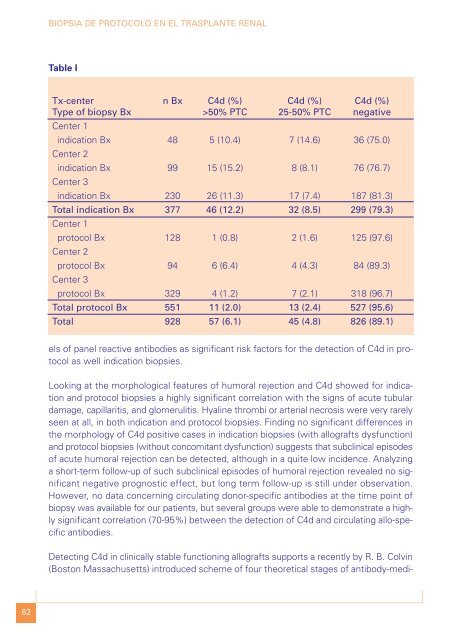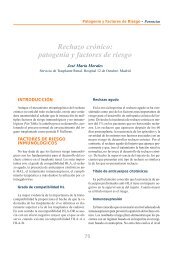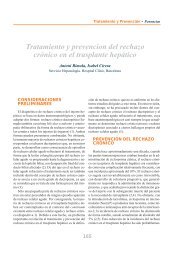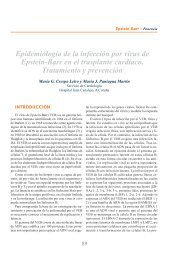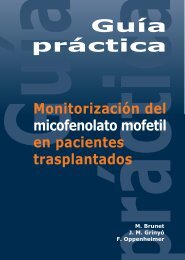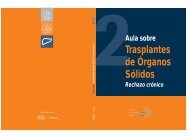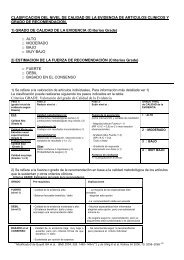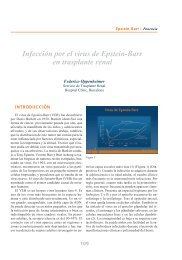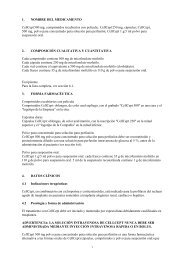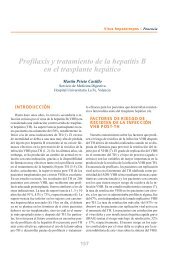Untitled - Roche Trasplantes
Untitled - Roche Trasplantes
Untitled - Roche Trasplantes
You also want an ePaper? Increase the reach of your titles
YUMPU automatically turns print PDFs into web optimized ePapers that Google loves.
BIOPSIA DE PROTOCOLO EN EL TRASPLANTE RENAL<br />
Table I<br />
Tx-center n Bx C4d (%) C4d (%) C4d (%)<br />
Type of biopsy Bx >50% PTC 25-50% PTC negative<br />
Center 1<br />
indication Bx 48 5 (10.4) 7 (14.6) 36 (75.0)<br />
Center 2<br />
indication Bx 99 15 (15.2) 8 (8.1) 76 (76.7)<br />
Center 3<br />
indication Bx 230 26 (11.3) 17 (7.4) 187 (81.3)<br />
Total indication Bx 377 46 (12.2) 32 (8.5) 299 (79.3)<br />
Center 1<br />
protocol Bx 128 1 (0.8) 2 (1.6) 125 (97.6)<br />
Center 2<br />
protocol Bx 94 6 (6.4) 4 (4.3) 84 (89.3)<br />
Center 3<br />
protocol Bx 329 4 (1.2) 7 (2.1) 318 (96.7)<br />
Total protocol Bx 551 11 (2.0) 13 (2.4) 527 (95.6)<br />
Total 928 57 (6.1) 45 (4.8) 826 (89.1)<br />
els of panel reactive antibodies as significant risk factors for the detection of C4d in protocol<br />
as well indication biopsies.<br />
Looking at the morphological features of humoral rejection and C4d showed for indication<br />
and protocol biopsies a highly significant correlation with the signs of acute tubular<br />
damage, capillaritis, and glomerulitis. Hyaline thrombi or arterial necrosis were very rarely<br />
seen at all, in both indication and protocol biopsies. Finding no significant differences in<br />
the morphology of C4d positive cases in indication biopsies (with allografts dysfunction)<br />
and protocol biopsies (without concomitant dysfunction) suggests that subclinical episodes<br />
of acute humoral rejection can be detected, although in a quite low incidence. Analyzing<br />
a short-term follow-up of such subclinical episodes of humoral rejection revealed no significant<br />
negative prognostic effect, but long term follow-up is still under observation.<br />
However, no data concerning circulating donor-specific antibodies at the time point of<br />
biopsy was available for our patients, but several groups were able to demonstrate a highly<br />
significant correlation (70-95%) between the detection of C4d and circulating allo-specific<br />
antibodies.<br />
Detecting C4d in clinically stable functioning allografts supports a recently by R. B. Colvin<br />
(Boston Massachusetts) introduced scheme of four theoretical stages of antibody-medi-<br />
62


